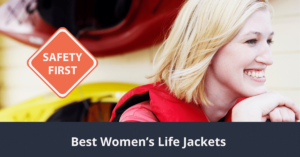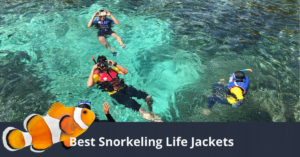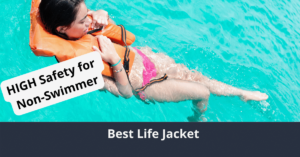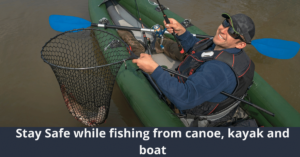Stand Up Paddleboarding or SUP is a new water sport designed to make the outdoors accessible and fun. This low key water activity involves balancing on a board and paddling through mostly calm waters in a lake or slow-moving river.
It’s an enjoyable activity, but you still need gear to help keep you safe. Our list of 2023’s best SUP life jackets will keep you compliant and help ensure that nothing happens to you while you’re out on the water. We’ve answered some questions you may have about choosing the right one, plus offer in-depth SUP life jacket reviews. Let’s take a look at the Best SUP Life Vests.
(You can also read our article on Best Kayak Life Jackets)
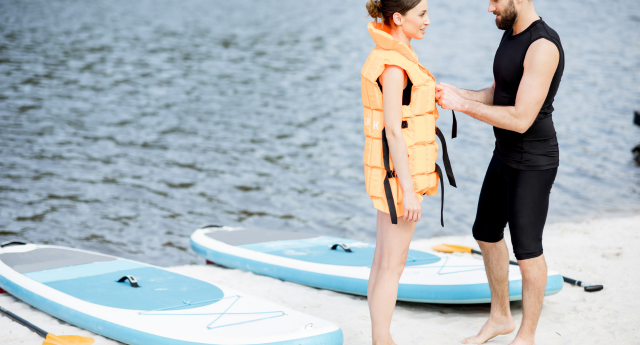
[Product Table]
Everything you will learn here
The Best SUP Life Vests – Editor’s Picks
This list of SUP life vests and personal flotation devices offer reliable service, keeping you safe during your watery adventures. Whether it’s your first time out on a SUP board or you’re a seasoned pro, these life vests are a must-have. Here’s our list in no particular order.
1. Stohlquist Edge Life Jacket
- GRADED SIZING - Stohlquist's Graded Sizing offers the best fit, and lowest footprint possible, for the widest range of body types. We have fine tuned each individual size, and sculpted the foam footprint and foam thickness to provide a better fitting, and more comfortable PFD for people of all sizes
- ERGONOMIC WRAPTURE SHAPED TORSO - The ergonomic WRAPTURE shaped torso utilizes reverse articulated foam & convex interior seams to contour to the natural shape of the body and provide a close, low profile fit. This allows us to fit young, smaller framed paddlers up to larger adults in the same style vest, while offering identical mobility across the size range
- MAXIMUM COMFORT - Padded, contoured shoulder straps; large arm openings; and a low-cut, offset front-zip entry, along with 4 side pulls, and a front waist buckle closure. Mesh sides also offer maximum ventilation
The Stohlquist Edge offers an unparalleled fit with multiple size options and four different cinch clips. Adjustable shoulders and a belt closure ensure the vest stays in place while large armholes give you freedom of movement.
The best part of the vest besides the fit is the extra roomy front pocket. It’s designed to hold all your essentials and could even help warm your hands up in a pinch. High visibility reflectors keep you safe, and the “Wrapture” molded torso encourages you to wear the vest all the time.
A side-entry zipper is convenient, and molded panels fit the size of the vest. Most companies only vary the strap size, but this gives you a better fit overall.
Pros:
- Molded, size-specific flotation panels
- Full-zip front pocket for plenty of storage
- Customization options for the fit beyond the cinch straps.
- Offers a range of colors
Cons:
- May not fit women’s chests
- Full back is fine for SUP but may not be comfortable for other water sports.
- Sizes run a little small.
(If you want to purchase the women life jacket, please visit: Best Women Life Jackets)
2. Onyx Movevent Dynamic Paddle Sports Vest
- Soft, lightweight flotation foam
- Mesh in lower back fits high back seats
- Attached whistle for safety
The Movevent offers some of the best range of motion through molded panels, mesh back and sides, and larger armholes. A wide range of sizes from extra small to extra additional large offers you a better, safer fit.
The front features SOLAS grade material for visibility while the mesh supports help prevent the vest from rising too high when you’re in the water. It’s suitable for SUP but also paddle sports where a full back may be uncomfortable.
Heavy-duty nylon with a softer nylon interior helps ensure the vest doesn’t rip or tear but also gives you a breathable, comfortable material to wear near wet skin. The flexibility of the material and the design make this a good option if you’re into multiple types of paddle sports.
Pros:
- Excellent fit with a mesh back
- Offers a wide range of motion
- Wide range of sizes
- Mesh drainage in the storage pockets
Cons:
- Pockets are on the small side.
- The sizes run a little large.
- Some of the colors don’t arrive true to tone.
3. NRS Vapor PFD
- Medium-profile PFD provides 16.5 lb. of floatation. Features soft, flexible foam for lightweight, all-day comfort. Side-entry design is easy to get in and out of.
- Four side and two shoulder adjustments allow for a custom fit. Huge zippered pocket on the front keeps small essentials secure. Hand-warmer pouch keeps your hands toasty on cold days.
- Lash tab on the front right shoulder keeps your knife or whistle handy. Reflective piping provides increased visibility in lowlight conditions. Made of 200D nylon with soft PVC foam and a stretchy nylon inner shell.
The NRS Vapor is a lightweight, low profile vest with side entry and easy cinch points. It has four side adjustments, and both shoulders adjust as well.
Unlike some PFD vests, the front panel leaves plenty of room for a larger chest, giving women a better chance of getting the right fit than with standard life jackets. It also has a low waist buckle to help prevent it from riding up in the water while the thick material is tear and rip-resistant.
It has a large (not waterproof) front pocket and plenty of room in the arms for a wide range of motion. The front is a little bulky, but this is just the construction of the front panels. It’s suitable for SUP but also a variety of paddle sports with the mesh back.
Pros:
- Wider berth across the chest area for body types that need more room
- Well placed lower waist buckle to help prevent it from riding up.
- Lightweight with multiple adjustment points
- Easy to adjust
Cons:
- The pocket isn’t waterproof.
- The front design is a little bulky.
- Lots of extra material on the straps (unless you have an exceptionally long torso)
4. NRS Women’s Siren
The NRS Women’s Siren is a jacket specially designed for smaller, female bodies. It features six different independent panels designed to mold more closely to a curved body along with six adjustment points for a better, more customized fit.
It’s suitable for a variety of ocean, river, and lake water sports. Mesh backing and sides allow better airflow, and the material is rip and tear-resistant. It’s a low profile jacket that uses a sculpted silhouette to cut down on bulk.
The large pocket is accessible through the side zippers, giving you easy access to the things you need. The design also allows greater circulation around the spine to help keep you fresh.
Pros:
- Circulation system to keep your temperature regulated.
- Large front pocket with convenient side access.
- Specially designed for curved bodies and female bodies.
- Excellent adjustment points
Cons:
- May not work for broader-chested users.
- Seaming is unreliable in some spots.
- Sizing is tricky to get just right.
5. Astral YTV Life Jacket PFD
- MADE FOR SAFETY: Stay afloat with PVC-free Gaia and PE foam inserts; Buoyancy rating of 16.5 lbs; USCG Type V Approval
- SECURE FIT: Torso Lock fit platform is easy to adjust, keeps the jacket in place as you move and is a favorite for freestyle kayakers; Pullover style with adjustable side buckles to fit; Weighs only 1.76 lbs
- DURABLE: Made to last for many adventures; 200 x 400 Denier Ripstop Nylon shell and 200 Denier High Tenacity Nylon liner; PolyPro webbing, heavy duty hardware and zippers with Self Locking Vislon Teeth
The Astral YTV is a simple pullover style life vest with soft foam panels and minimalist design. If annoying straps and ties prevent you from wearing your life jacket in the first place, this could be an excellent alternative to standard cinch types.
The panel fits standard bodies and has two pockets on the front for more accessible storage. The exterior is a 200 denier nylon, a highly tear-resistant material, and the design is both Type III and Type V approved.
This vest is a PVC free material, and Astral company uses as many recycled materials as possible to ensure that their footprint is small. Self-locking zippers and the webbing ensure a long-lasting life jacket.
Pros:
- Pullover style vest reduces hanging straps.
- Type V and Type III certified
- Minimalist design with excellent breathability
- Company has an eco-friendly approach
Cons:
- No lash or pocket for safety whistle
- Pockets are too small for standard storage.
- No front zipper
6. MTI Adventurewear High Buoyancy Life Vest
MTI created this life jacket PFD to hold an extraordinary amount of weight. It features a 25-pound buoyancy rating, designed not only for casual water sports but water rescues as well. The fleece-lined hand warming pockets help keep you safe and comfortable even in less than ideal conditions.
It has reflective material for safety and good airflow vents to help ensure proper circulation. Four front pockets offer good storage, including a pocket for a whistle. The adjustable shoulder straps help you get the right fit, while a 500 denier Cordura nylon exterior is long-lasting.
A zippered front entry and waist belt keep the jacket in place. It’s built for the demands of paddling in open waters, including rough rivers or oceans, potentially conditions where you may need to survive for a while.
Pros:
- High-performance tough jacket
- Ultra buoyant option for open waters
- Generous reflective panels and adjustable straps
- Suitable for a variety of water bodies
Cons:
- Buoyancy is a trade-off for bulk.
- Pocket zippers are too small.
- Mesh could be a little sturdier.
7. Hardcore Water Sports High Visibility PFD
- Size - This is the perfect extra vest for your boat. The adult universal size is adjustable to fit most adults that would wear a S, M, or L adult t-shirt. Coast Guard approved for persons over 90 lbs. with a chest size between 30"-52". Simply loosen the straps all the way before you put the vest on. Then tighten each strap so the lifejacket conforms to your body shape.
- Color - High Visibility Neon Yellow color makes the user highly visible in every water situation. Five bright color options - one of them is sure to match your family style!
- Style - Hardcore Water Sports is known for it's distinct style on all liquid surfaces. Open sides provide for a breath-able fit and provide superior benefits in paddle sports mobility. This vest is truly the most versatile versatile floatation device on the market today, used often as a fishing vest, kayaking PFD, wakeboarding life jacket
The Hardcore Water Sports vest offers a good, all-purpose PFD for when you need to keep an extra onboard for compliance. It provides safety features like reflective material and a durable nylon exterior to resist tears.
The side zipper allows easy access without having to adjust the cinch belts a lot each time you wear it. Open sides are more comfortable and more breathable, encouraging you to keep this vest on while you’re in the water.
High visibility material and reflectors help with rescue while the Type III design keeps your head above water even with brief unconsciousness. Cordura nylon and closed-cell foam are solid materials, giving you the freedom to participate in a variety of river, ocean, and lake sports, not just SUP.
Pros:
- High visibility material for safety
- Affordable option
- Comfortable side vents with a waist belt
- Excellent flotation design
Cons:
- Waist belt doesn’t adjust as much as we’d like
- Sizing recommendations can be a little inaccurate.
- No pockets
SUP Life Vest Buyers Guide – Making The Best Purchase
Let’s take a look at what goes into deciding on a SUP life jacket. It takes more than just a bit of flotation foam inside some nylon and calling it a day. The Coast Guard has a system for determining the efficacy of PFDs as well as what type to use in different situations.
Here’s everything you need to know about the world of life jackets for water activities in the ocean, lake, or river.
Types of SUP PFDs
The coast guard defines vests based on their usage and their performance level. These categories help you decide what type of life vest you need and which models to avoid when you’re choosing your PFD.
- Type I – This type is designed for heavy-duty use far away from a rescue in rough waters. These bulky vests are the type you see with fishing crews, for example, where rescue may be difficult.
- Type II – These types are found on many boats to provide coast guard compliance. They’re designed for calm waters where rescue is close, such as slow-moving, small boats.
- Type III – This is where vests get interesting for you. Water and paddle activities require a jacket that can keep you afloat even when you’re unconscious. Type III is certified to do just that with a proper fit and size.
- Type IV – Non-vest PFDs fall into this category because they’re simply a float you toss out to someone in need of a hand. The classic lifesaver ring is a good example.
- Type V – These are specially designed floats meant for special situations like freezing water or other special events. They also have additional certifications, meaning you can have a Type V also certified to be a Type III.
Once you’ve made your way through these basic types, there are performance levels designed to help you choose based on your ability to swim, comfort in the water, and the remoteness of the location where you’ll be paddling.
You must be honest about your swimming abilities and where you’ll spend most of your time when you’re in the water.
- Level 50 – Competent swimmers who are very comfortable and trained in the water are suitable for a Level 50. Rescue or a shoreline is nearby, however.
- Level 70 – Rescue and shoreline are close by in calmer waters, but these floats won’t keep you afloat if you’re unconscious.
- Level 100 – When you’re going to be in open waters away from a visible (or swimmable) shoreline and rescue isn’t so quick, a Level 100 vest helps keep you safe.
- Level 150 – These vests will turn an unconscious swimmer right side up to keep the head and airway above water until rescue happens. They require proper sizing and fit to facilitate rescue.
- Level 200 – These have relevance for offshore use in extreme water conditions where a quick rescue is highly unlikely. You won’t typically find these in recreational water sports.
Choosing a Life Jacket
There are a few different components that go into life jackets. Once you’ve chosen the type and performance, consider a few of these different elements as you’re choosing your life vest.
Design
The design for paddle sports vests allows you more freedom of movement than the standard life jacket. Larger armholes and mesh across the sides and back provide better air circulation and breathability while many designs have a higher back for both seated and SUP activity.
Adjustable shoulder straps and waist belt can increase comfort and help ensure that you can wear the coat all day. Cinch belts also keep it from riding up over your ears and mouth while you’re in the water.
There are two basic entry types, as well. While both are safe and secure with the right fit, you should consider both carefully.
- Side entry – Side entry vests have a zipper on the front or lateral side to allow easy entry with fewer adjustments from the cinch belts.
- Pullover – A pullover doesn’t have a belt and can help you feel more secure, but it could be tough for shoulder or back injuries.
The Coast Guard recommends a full vest for SUP just like everything else. You have the option of a flotation belt to help with your buoyancy or an inflatable option that gives you a complete range of motion, but a full vest is best.
Inflatable options include:
- Manual inflatables – This style requires you to inflate the vest, usually with the pull of a string. These are best used as a supplement to another PFD system because if you’re unconscious, you can’t deploy the flotation option.
- Automatic inflatables – Automatic inflatables deploy flotation in contact with water. They require a CO2 cartridge that you must maintain and replace periodically. There’s a lot that can go wrong with one of these, and the Coast Guard doesn’t recommend them either in place of a full vest.
Materials
Life jackets must be able to stand up to the environmental stressors such as UV rays, water damage, and rigorous activity. PDF material should stand up to these stressors. Check on these components of the vest as well:
- Zippers – Zippers should preferably have interlocking teeth to seal the vest against movement and water.
- Seaming – All seaming should be reinforced to prevent tears.
- Cinch straps – The waist belt and the straps should provide customization for the sizing of your PFD and prevent it from riding up while you’re in the water.
There are appropriate materials for water activities that allow your flotation to dry and help reduce the weight while you’re in the water. Life vests use a variety of materials, but three are the most common types.
Nylon
Nylon is a highly durable outdoor material designed to be both rip and tear-resistant. It’s a tightly woven material. If you choose nylon, make sure that it’s a high enough denier to withstand environmental elements — 200 denier at least.
Cordura nylon is an excellent exterior material, sturdy and durable, while Oxford nylon is a soft interior option suitable for wearing against bare skin. Nylon can take a while to dry out and is prone to mold or mildew without proper air circulation.
Neoprene
Neoprene is a newer performance fabric designed for active sports. The fabric isn’t very breathable, but when mixed with other materials, it can help your vest dry faster. Neoprene can sometimes be more expensive.
It’s good if you aren’t sure you’re going to get or stay wet. If you want to wear something just in case, but you plan to spend most of your time on dry land (or on your board), you’ll want something that dries more quickly.
Vinyl
Vinyl is durable and long-lasting, but it’s heavier than average. It’s bulky and could restrict some of your movements, but if you often head out in less than ideal conditions, it can withstand environmental factors pretty well.
Interior Flotation
Interior flotation gives you the buoyancy you need to stay safe, but different designs offer different benefits. In some vests, the panels move differently to allow you better rotation and more comfort.
The panels are typically closed-cell foams that retain their buoyancy despite being in the water. Solid panels are often more affordable, but independent panels offer a better range of motion.
Storage
SUP boards don’t offer a lot of places for you to store your gear. A life vest can give you a few places to stash essentials, freeing up your hands and your mind.
Many vests have simple pockets to store things like a small radio. Others have larger pockets that allow you to store things like a phone in a waterproof bag or other essentials. Specialty vests may also have pockets designed to keep your hands warm.
Other storage options include lash strips across the back to attach accessories and features like a carabiner hook for a safety whistle or a knife. A great option is a vest with a bladder pocket across the back so that you always have fresh water when you need it.
Comfort
One of the most essential features of a PFD is comfort. The right fitting vest will keep you safe, and comfort helps ensure that you put it on and keep it on. You must wear the jacket for it to be effective, so make sure you choose a vest that feels good for you.
Buoyancy
Buoyancy is the amount of force you’ll need to keep your head above water. Vests will typically hold a person using between seven and 12 pounds of force. To be Coast Guard certified, it must have at least 15 pounds of buoyancy.
You must have a coast guard certified life jacket on board your boat to be compliant, but you should carefully consider the vest you choose. Higher buoyancy means higher bulk, so choose your balance wisely.
Price
The budget is probably on your mind, but there’s good news. You can find SUP life vests in a variety of price ranges. There are high-end vets with lots of bells and whistles, but you can also get an affordable vest that provides necessary protection with Type III distinction.
Instead of bargain shopping your life vest, think about how long you’ll be participating in SUP or other paddle activities. The price for a quality jacket could pay for itself in the long run, so consider carefully what you budget.
Advantages of A SUP Life Vest
You may think you’re a capable swimmer, but water activities can quickly turn into an emergency. Unexpected water, cold snaps, bad weather — even waterlogged clothing — can make it difficult for even a capable swimmer to manage.
Life vests increase your chances of survival in any of these unique situations and lengthen the time crews have to rescue you. Many drownings occur because someone chose to leave the life jacket behind instead of wearing it.
Shock is another risk factor while you’re in the water. Shock can make it difficult for you to make decisions or do what you need to do to get out of the water safely. A jacket is extra protection.
Coast Guard regulations require you to wear a suitable life vest in public waters no matter what you’re doing there. Choosing a Type III vest puts you in compliance and allows you to stay in compliance with these regulations and ensure that you can keep returning to your favorite place.
A full life jacket may seem bulky at first, but it’s going to be the most reliable way to keep your head out of the water. Belts and inflatable vests are comfortable in the moment, but we strongly recommend that you get used to wearing a standard PFD vest/jacket.
Drawbacks
There aren’t many drawbacks to staying alive, but a life jacket does have a few drawbacks. The vest can feel uncomfortable at first if you’re used to having total freedom of movement, but it’s important to get the right fit so you’ll wear it.
Life jackets may be too bulky for your intended use, or they could be ill-fitting if you don’t know how to get the right fit. It could malfunction in the water if you don’t have the tools to choose the right one.
A life jacket isn’t a sure thing. You must have the right type, and you need to have the size for the PFD to work the way it’s supposed to. While you might suffer temporarily because of the bulk, it’s going to save your life.
Using Your SUP PFD The Right Way
The life jacket must be the right fit before you can trust that it will work. Here’s what to do.
- Use a cloth tape measure to measure around your body at the widest point. In some cases, this may be your abdomen, so be sure you measure there.
- Look at the manufacturer’s size ranges and find where your measurement falls. Take a look at the reviews or try the jacket on if you can. If you’re between sizes, you may want to size down so that the vest fits snugly.
- Shoulder strap adjusters can help ensure that the vest covers your torso in the right place. A waist belt that fits well keeps it from riding up past your mouth or ears while in the water.
- Once you’ve made your selection, put your vest on, and secure it. It should fit tightly like a shoe without restricting your movements.
- Wade into the water up to your chest and check the movement of the vest. It shouldn’t move above the mouth or ears.
- When you feel comfortable, draw your knees up to your chest. The life jacket should hold your weight in the water. If it doesn’t, it’s not the right model.
Each time you put your vest on, you should check that everything is in working order. Test the jacket every once in a while to be sure that it still has buoyancy.
Maintaining Your SUP Life Vest
Maintenance is an integral part of the life of your vest. Follow these steps to ensure that your vest has the best chance of lasting for a long time.
- Hang your vest to dry each time you use it. Ensure there is good air circulation to help prevent mold and mildew from building up in the seams.
- Every once in a while, you must clean your vest. Use mild dish soap or detergent and dilute with water.
- Rinse out your life jacket underneath the faucet.
- Use a gentle brush or rag to apply soap and gently brush the vest to remove mildew and mold. Do not twist or press the foam, or you could damage the form.
- Rinse the jacket out thoroughly to remove any trace of soap and allow it to dry completely with good air circulation.
Safety Tips
We cannot overstate how important it is to wear your life vest with all water sports. The chances of shock, injury, or weight could all interfere with your swimming ability even when you’re a great swimmer.
Adjust your vest well and ensure that you keep up with the maintenance it needs to do its job. Also, make sure you carefully measure for your exact size and try on vests if you’re able to.
If you’re not convinced that you need to wear a PFD all the time you’re in the water, we have something for you. Our website has an interactive page where you can explore the official statistics for US Drowning Statistics, Worldwide Drowning Statistics, and Drowning Prevention.
Wear your vest correctly each time you decide to go on a SUP adventure because you’ll want the best chance of rescue if something happens. Go over the following things to keep your life jacket working correctly.
- Check your life vest regularly for tears or ripped seams and other wear and tear.
- Before you head out with your jacket for the first time, check its buoyancy. Be sure that it doesn’t come up over your ears or mouth.
- Always put your PFD on before you go out on the water and ensure that you wear it the entire time you’re out, even if you’re a confident swimmer.
Best SUP Life Vests Comparison Chart
| Product Name | Price | Size | Safety | Unique Features |
|---|---|---|---|---|
| Stohlquist Edge Life Jacket | $ | S, M, L, XL, XXL | Type-3 PFD | Molded, size-specific flotation panels |
| Onyx Movevent Dynamic Paddle Sports Vest | $-$$ | XS, S, M, L, XL, 2XL | Heavy-duty nylon with a softer nylon interior helps ensure the vest doesn•t rip | Excellent fit with a mesh back, Mesh drainage in the storage pockets |
| NRS Vapor PFD | $ | SM, M, XXL | Well placed lower waist buckle prevent from riding up | Thick material is tear and rip-resistant |
| NRS Women•s Siren | $ | XS, M, L, XL, XXL | The material is rip and tear-resistant | Specially designed for curved bodies and female bodies |
| Astral YTV Life Jacket PFD | $$ | M, L, XL | Type-V and Type-III certified | Pullover style vest reduces hanging straps |
| MTI Adventurewear High Buoyancy Life Vest | $-$$ | S, XL | Reflective material for safety and airflow help ensure proper circulation | Generous reflective panels and adjustable straps |
| Hardcore Water Sports High Visibility PFD | $ | M, L, XL | Type-III, High visibility material for safety | Comfortable side vents with a waist belt |
Wrap Up: Best SUP Life Vest
SUP is such a fun activity, but you’ll need to make sure you’ve always got the right safety gear. Rather than relying solely on ideal conditions to swim in, use a life jacket, and give yourself the best chance of surviving until rescue.
It only takes an adult about 60 seconds to drown, and that can happen while you’re unconscious. A life jacket that keeps your airway above water could save your life. Use our tips and our recommendations to find one that works with SUP and stay safe out on the water.
FAQ: Best SUP Life Vests
Last update on 2024-07-27 / Affiliate links / Images from Amazon Product Advertising API

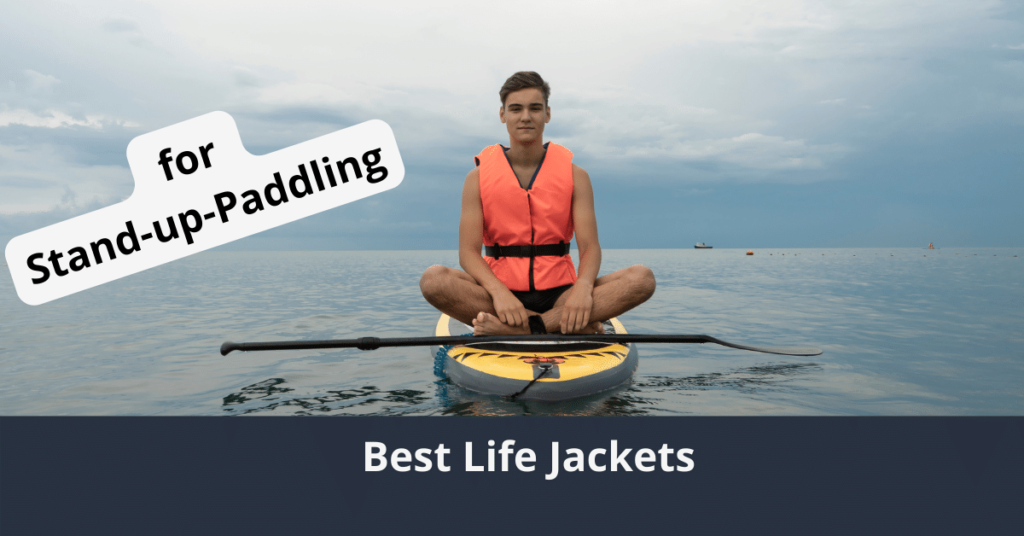


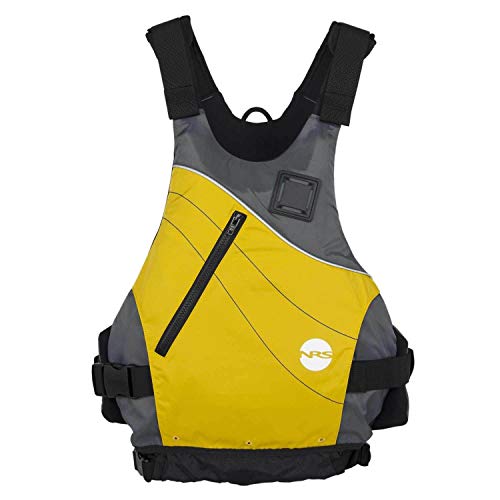




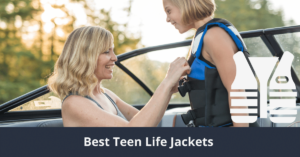

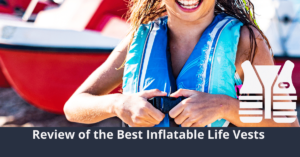
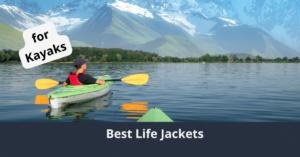
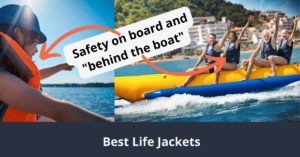

![7 Best Jet Ski Life Jackets with awesome fit [2023 guide] 17 Best Jet Ski Life Jacket](https://insmoothwaters.com/wp-content/uploads/2022/09/Best-Jet-Ski-Life-Jacket-300x157.png)
